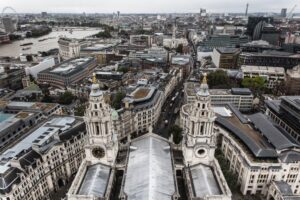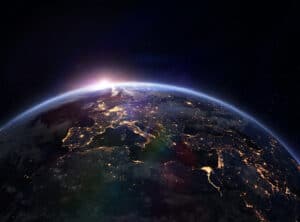On the 23rd August President Donald Trump declared a national emergency in California as wildfires swept across the State. Almost 20 days on, wildfires are still surging across the West of the United States with fires also being reported in Oregon, Utah, Washington, and Colorado. In light of this it would seem pertinent to ask the questions of how wildfires are started, what are the impacts and are they getting worse?
Whilst wildfires can be started by multiple environmental and human factors the most common cause is human negligence which has found to have occurred in over 80% of wildfires.1 Human negligence was the primary cause for the ongoing El Dorado wildfire in California that has its provenance in a ‘gender reveal party’ in which a family ignited a pyrotechnic device designed to display blue for a boy or pink for a girl, consequently catching fire to dry grass in the area. The fire started by this pyrotechnic device has since gone on to grow to over 10,000 acres.2 Other causes included falling electrical pylons or lightning strikes amongst others. The two largest wildfires of this season, termed the SCU Lightning Complex and the LNU Lightning Complex, near San Jose and Napa respectively, were both started after more than 10,000 lightning strikes struck the American state in 72 hours.3 As of 9th September the SCU Lightning complex, whilst 96% contained, has burned 396,624 acres in five counties across 22 days and the LNU Lightning complex, determined as 93% contained, burned 363,220 acres in a further five counties across 23 days.4 5
These wildfires, along with an estimated 650 others in the state, have burnt more than 2.2 million acres of land, causing seven fatalities and the destruction of 3,849 structures and are currently being fought by 14,000 firefighters.6 7 The sheer devastation caused by the fires has led state governor Gavin Newson to declare states of emergency in different parts of California on both 18th August and 6th September. Elsewhere in the American west, major wildfires have broken out in Colorado throughout July and August, the largest of which, called the Pine Gulch fire, also started by lightning, has become the state’s second largest wildfire in history, eating up 125,000 acres.8 New wildfires have also been reported by Oregon’s governor on 9th September, with high winds causing the fires to rapidly expand and reach a footprint ‘nearly twice the size of New York City’.9 It is feared that the fires, which have so far consumed five towns, could potentially leave behind a high death toll.10
As fires sweep across states they not only leave behind physical devastation but also financial, both in the long and short term. To this effect Bloomberg have reported that since 2017 wildfires have resulted in economic losses of ‘at least $50 billion’.11 Another, broader, analysis, conducted by AccuWeather and including insured and uninsured losses (‘for damage to homes and businesses as well as their contents and cars, job and wage losses, farm and crop losses, infrastructure damage, auxiliary business losses, school closures and the costs of power outages to businesses and individuals’ in addition to ‘economic losses because of highway closures, evacuations and increased insurance premiums throughout the state, firefighting costs, flight cancellations and delays and the current and long-term residual health effects on those impacted by dirty air’) has estimated the total damage and economic loss incurred by California in 2019 to be $80 billion.12 The cost of putting out the fires comprise a fraction of this total cost, at $163 million.13 These direct and indirect losses are also listed by the California Council on Science and Technology who also include supply chain impacts and housing market impacts.14 The myriad ways in which wildfires can impact your life is truly expansive, for example the forced closure of hundreds of miles of highway across Colorado state.15 In California legislation has been implemented to temporarily ban insurers from cancelling policies on 800,000 homes in or near parts of the state which are prone to wildfires, flooding or other natural disasters last year. However, this ban is set to expire soon with the policy not able to be renewed, as a result of this it is expected that many insurers will retreat from high risk areas of the state, and without insurance many prospective buyers will be refused mortgages from banks. Consequently this will have a twofold impact on the area, making houses harder to buy or sell, and decreasing the tax base as more people leave the area.16
Health impacts have also been a big concern during the recent outbreaks of wildfires, especially considering the wide reach of smoke which can impact health even continents away. An example of this has been the health warning issued across the Vancouver area in Canada as a result of ongoing wildfires across the border in Washington state. Consequently, Environment Canada has issued health warnings on air quality ranging from 9 to 10+. For comparison, the agency advises the public to reduce ‘strenuous outdoor activities’ at level 8 and above.17 This advisory by the Canadian government is better understood when taking into account research by Stanford Health Care who have found that, aside from the respiratory issues caused by wildfire smoke, the smoke can also increase the likelihood of heart attacks and strokes, with studies finding that this higher chance persists even two to three days after breathing in the bad quality air.18 Whilst the level of harm wildfire smoke can cause you is dependent on what is burning, how hot it is burning and how far the smoke has travelled, wildfire smoke with contain thousands of compounds with most containing carbon monoxide, volatile organic compounds, carbon dioxide and nitrogen oxides. Added to this, the majority of pollutants in smoke are categorised as PM2.5, meaning that the particle matter is less than 2.5 micrometres. PM2.5 also means that pollutants can bypass the bodies usual mechanisms such as mucus and phlegm, therefore, being absorbed into the bloodstream and increasing the risk of asthma, heart attack and stroke.19 A recent study conducted in the United States also found that increases in PM2.5 greatly affect those with COVID-19, finding that a small increase in the particle matter results ‘in a large increase in the death rate from COVID-19’.20
It is important to understand that, when naturally occurring, wildfires are an important element of a healthy and balanced ecosystem, helping to create ‘a landscape more diverse in age, which reduces the probability of disease or fire spreading through large areas’.21 Professor John Roise of North Carolina State’s College of Natural Resources has pointed to the need for wildfires in order to clear away heavy brush and invasive weeds as well as thinning the tree canopy to allow more light to reach the forest floor. This in turn stimulates the regeneration of grasses, herbs and shrubs that provide food for animals and birds, thereby diversifying the ecosystem.22
So, have wildfires gotten worse in recent years? It would appear that yes they have. Looking at past we can see that since the 1970s the western United States has seen their wildfire season grow from five months to seven months.23 On top of this the number of acres burnt by wildfires has doubled from an average of 3.3 million acres a year in the 1990s to 7 million since 2000.24 In 2018 California broke a record held since 1987, recording 1.96 million acres of land burnt, a record that has been far surpassed already in the state’s current ongoing wildfire season.25 A large factor in why the seasons are getting longer and fiercer is climate change, with both California and Colorado experiencing terrible droughts before serious wildfires meaning that vegetation turns to kindling and becomes easily combustible.26 27 In addition to this, poor forestry stewardship conducted by land management agencies throughout the 1900s involving the suppression of all wildfires, whether naturally occurring or manmade, has created a forest floor filled with fuel for fires. Whilst this policy was enacted in order to timber natural resource supplies, it has in fact lead to the build-up of vegetation on the forest floors. This coupled with longer heatwaves and more prevalent droughts creates a greater risk for larger and more sustained wildfires.28
Experts have pointed out that one of the first things needed to be done to help mitigate the effects of wildfires is ‘prescribed burnings’ which involve the lighting of controlled fires by firefighters, when the weather is cool, in areas of ‘excessive amounts of brush and other full sources on the forest floor’.29 Not only will these controlled fires help to clear away potential forest fire fuel, and therefore prevent future accidental fires from burning out of control, they will also encourage new growth and stimulate the natural ecosystem. In light of this the authorities should be dissuaded from developing on fire-prone areas, and failing this those who live in such areas need to be educated on good forest stewardship and to be taught that fires are not always bad.29 To combat fires effectively when they occur, Bloomberg have also suggested that former prisoners who have received firefighting training whilst in jail should be allowed to apply for a full-time job after being released.30 With COVID-19 already straining many departments financially, cost-effective measures to combat and mitigate wildfires are sorely needed – especially when, in the long term, wildfires have the potential to cause more economic damage over time than a pandemic.
Alongside the United States, abnormal wildfires have also been reported in Siberia and Russia, as well as others, all of which are growing signs of things to come should the concerns towards climate change not be addressed. Although effective forestry management is crucial to efficiently control wildfires by developing fire resilience, the combating of climate change is imperative, not only for mitigating the risk of wildfires but also to combat other effects of climate change such as the increased prevalence of drought, hurricanes and floods. Whilst COVID-19 has had a debilitating effect on the international community it has also presented an opportunity to reset how life is approached and to restart again in an environmentally conscious and stable manner.


